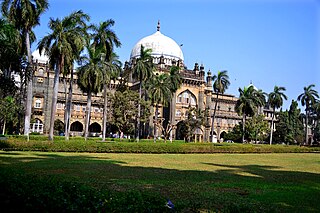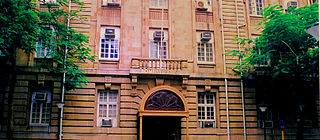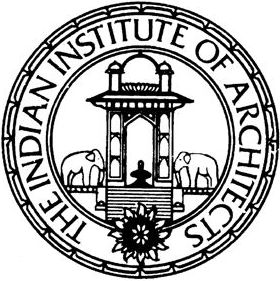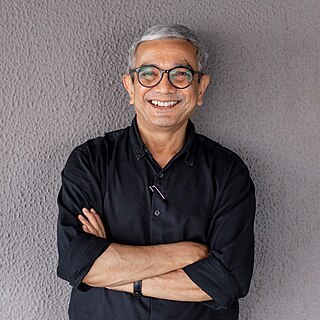George Wittet | |
|---|---|
| Born | 1878 |
| Died | 1926 (aged 47–48) |
| Occupation | Architect |
| Buildings | |
This article needs additional citations for verification .(January 2015) |
George Wittet (1878-1926) was a Scottish architect who worked mostly in Mumbai, India.
George Wittet | |
|---|---|
| Born | 1878 |
| Died | 1926 (aged 47–48) |
| Occupation | Architect |
| Buildings | |
This article needs additional citations for verification .(January 2015) |
George Wittet (1878-1926) was a Scottish architect who worked mostly in Mumbai, India.

George Wittet was born in Blair Atholl, Scotland in 1878. He studied architecture with a Mr. Heiton of Perth, Scotland, and worked in Edinburgh and York before moving to India.
Wittet arrived in India in 1904 and became an assistant to John Begg, then Consulting Architect to Mumbai. The two men played a large part in the development and popularization of Indo-Saracenic architecture, based on careful study of Indian models. [1]
On 12 May 1917, Wittet, by then Consulting Architect to the Government of Mumbai, was unanimously elected as the first President of The Indian Institute of Architects. [2]
Wittet designed some of Mumbai's best known landmarks: the Chhatrapati Shivaji Maharaj Vastu Saghralaya, the Gateway of India, the Institute of Science, the Small Causes Court at Dhobitalao, the Wadia Maternity Hospital, Bombay House, the King Edward Memorial Hospital, the Grand Hotel and other buildings at the Ballard Estate, by the Mumbai Docks.
In Karachi, he designed the Karachi Port Trust (KPT) building. [3]
He died of acute dysentery in Mumbai in 1926, and is buried in the Sewri cemetery.

Chhatrapati Shivaji Terminus (officially Chhatrapati Shivaji Maharaj Terminus since 2017, formerly Victoria Terminus (VT), Bombay station code: CSMT (mainline)/ST (suburban)), is a historic railway terminus and UNESCO World Heritage Site in Mumbai, Maharashtra, India.

Chhatrapati Shivaji Maharaj Vastu Sangrahalaya, (CSMVS) formerly named the Prince of Wales Museum of Western India, is a museum in Mumbai (Bombay) which documents the history of India from prehistoric to modern times.

The Gateway of India is an arch-monument completed in 1924 on the waterfront of Mumbai (Bombay), India. It was erected to commemorate the landing of George V for his coronation as the Emperor of India in December 1911 at Strand Road near Wellington Fountain. He was the first British monarch to visit India.

Charles Mark Correa was an Indian architect and urban planner. Credited with the creation of modern architecture in post-Independent India, he was celebrated for his sensitivity to the needs of the urban poor and for his use of traditional methods and materials.

Indo-Saracenic architecture was a revivalist architectural style mostly used by British architects in India in the later 19th century, especially in public and government buildings in the British Raj, and the palaces of rulers of the princely states. It drew stylistic and decorative elements from native Indo-Islamic architecture, especially Mughal architecture, which the British regarded as the classic Indian style. The basic layout and structure of the buildings tended to be close to that used in contemporary buildings in other revivalist styles, such as Gothic revival and Neo-Classical, with specific Indian features and decoration added.
John Begg, was a Scottish architect, who practised in London, South Africa and India, before returning to Scotland to teach at Edinburgh College of Art from 1922 to 1933.

The Sir Jamsetjee Jeejeebhoy School of Art is the oldest art institution in Mumbai, India, and is affiliated with the University of Mumbai. The school grants bachelor's (B.F.A) degrees in Painting, ceramic, Metal work, Interior decoration, Textile design and Sculpture as well as Master's degrees (M.F.A) in Portraiture, Creative Painting, Murals, Sculpture, and Printmaking.

Claude Batley F.R.I.B.A., F.I.A.A., was an English architect who as practitioner, teacher and President of the Indian Institute of Architects from 1921 to 1923, played an influential role in development of modern architecture in India in the first half of the 20th century.
The year 1915 in architecture involved some significant architectural events and new buildings.

The Ballard Estate business district is situated in the financial district of Fort. Located between Chhatrapati Shivaji Maharaj Terminus and Fort in South Mumbai, it hosts the offices of shipping companies and the headquarters of the Mumbai Port Trust at the Port House. It has the Reliance Centre, many mid-priced hotels and a noted Irani cafe, Britannia.

Hafeez Sorab Contractor is an Indian architect. He has designed many skyscrapers in India, primarily in the city of Mumbai. As of 2019, he is the architect of the three tallest buildings in India – The 42 in Kolkata, and the twin towers of The Imperial in Mumbai. He was awarded the Padma Bhushan in January 2016 by the Government of India.

Bombay House is a historic privately owned building in the city of Mumbai, India that serves as the head office of the Tata Group.
The architecture of Mumbai blends Gothic, Victorian, Art Deco, Indo-Saracenic & Contemporary architectural styles. Many buildings, structures and historical monuments remain from the colonial era. Mumbai, after Miami, has the second largest number of Art Deco buildings in the world.

The Indian Institute of Architects (IIA) is the professional national body of architects in India. It was established in 1917 with its headquarters in Mumbai, India. It is associated with the International Union of Architects (UIA) Commonwealth Association of Architects (CAA) and South Asian Association for Regional Cooperation of Architects (SAARCH).

Sir George Washington Browne was a Scottish architect. He was born in Glasgow, and trained there and in London. He spent most of his career in Edinburgh, although his work can be found throughout Scotland and beyond. He was involved in nearly 300 projects, including many public and commercial buildings. One of his most notable buildings is Edinburgh's Central Library, and he became recognised as an authority on library planning and design. He came to national attention after winning a competition to design a bridge over the River Thames in London, although this was never realised. He was the first architect to be elected as President of the Royal Scottish Academy. He also served as President of the Edinburgh Architectural Association, and was instrumental in setting up the Royal Fine Art Commission for Scotland.
Sir William Emerson was a British architect, who was President of the Royal Institute of British Architects (RIBA) from 1899 to 1902, and worked extensively in India. He was the original architect chosen to build Liverpool Cathedral.

Ballar Bunder Gatehouse is a Grade I Heritage structure that has been converted into a maritime museum, located at Ballard Estate in the old Fort area of Mumbai, India. It was built in 1920 to commemorate the realignment of the harbour and is located where Ballard Pier, a small pier once existed with an approach jetty at right angles to the pier. The building was among the five entries from the Mumbai for the 2009 UNESCO Asia-Pacific Heritage Awards for Culture Heritage Conservation. It is one of the stops on Special tour of Museums in the city, a tour organised by BEST and MTDC as well as the Naval Dockyard Heritage Walk, conducted by the Naval Dockyard on the first Sunday of every month.
Rahul Mehrotra is Founder Principal of architecture firm RMA Architects of Mumbai + Boston, and is Professor of Urban Design and Planning and Chair of the Department of Urban Planning and Design at the Harvard Graduate School of Design (GSD) in Cambridge, Massachusetts.

Bimal Hasmukh Patel is an architect from Ahmedabad, India, with over 35 years of professional, research and teaching experience in architecture, urban design and urban planning. He was the President of CEPT University in Ahmedabad from July 2012 to January 2024. He leads HCP Design Planning and Management Private Limited, an architecture, planning and project management firm. He also founded Environmental Planning Collaborative, a not-for-profit, planning research and advocacy organization.

The Karachi Port Trust Building, also referred to as the KPT Building, is a large colonial-era building in Karachi, Pakistan that serves as headquarters for the Karachi Port Trust, which administers the Port of Karachi. The building dates from the height of the British Raj, and was inaugurated on 5 January 1916.